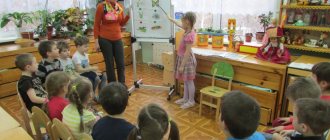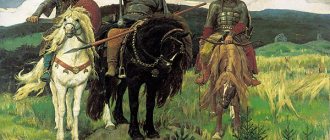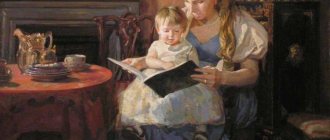Senior group. Senior preschool age. Children 5-6 years old
Abstract of the OOD in the senior group “Excursion to the mini-museum of Russian folk toys” Purpose: acquaintance with Russian folk toys. Objectives: - to create conditions for children to consolidate knowledge about Russian folk toys: Dymkovo, Filimonovsky, Bogorodsky, Stary Oskol, rag dolls, nesting dolls; - to form an idea of the materials from which...
Scenario of the event “Mini Museum of Bread” in the senior speech therapy group Educator: Dear guests! Our group has a mini-museum “Bread”
.
Now the children will present exhibits that are in our museum. M. Gelya: “This is our mini-museum of “Bread”
.
There is a cake, Santa Claus’s bakery, a loaf of bread, a fairy tale theater “Spikelet”
, a plowman, a lark bird,…
Pedagogical project “Mini-museums in kindergarten”
Category: Methodological piggy bank Created: 10/27/2015
/Direction “Patriotic Education”/
Teacher Latysheva A.N.
In recent decades, many complex, contradictory events have occurred in our country in public life, politics, and in the system of state and local self-government. The problem of patriotic education fell out of sight of a significant part of scientists and politicians for more than ten years. Unfortunately, today, through the efforts of foreign media, Russia’s contribution to world civilization is being intensively leveled. In articles and books, the pages of history are inexplicably redrawn, “slavish worship” of everything foreign is welcomed, and the achievements and discoveries made by Russian scientists are belittled. It’s safe to say that the younger generation is experiencing a decline in interest and respect for Russia’s past. Ancient wisdom reminds us: “A man who does not know his past. He doesn’t know anything.”
Patriotism is the moral basis of the viability of the state. Therefore, civil-patriotic education today is one of the most important links in the system of educational work. It is the emphasis on knowledge of history and culture that will help the younger generation in the future treat the cultural traditions of other peoples with respect and interest.
The identification of this task is natural for the new standards of preschool and school education. The Federal State Educational Standard for Preschool Education (FSES DO) identifies as a special task of preschool education the need for the moral development of children and the creation of conditions for children to assume a civic position.
Patriotic education of preschool children is not only the cultivation of love for one’s home, family, kindergarten, city, native nature, the cultural heritage of one’s people, one’s nation and a tolerant attitude towards representatives of other nationalities, but also the cultivation of a respectful attitude towards the worker and the results of his work , native land, defenders of the Fatherland, state symbols, state traditions and national holidays.
The specifics of the educational space of Tomsk make it possible to highlight such a priority direction in the education of preschool children as museum pedagogy .
The city's museums, being centers for instilling love for the Fatherland and introducing spiritual values, fulfill their educational mission. The nature of a child’s communication with a museum largely depends on the degree of development of his perception, interests and ability to navigate the world around him. But, unfortunately, today the spiritual and intellectual potential of the museum is not used sufficiently due to the “loss” of an entire generation of visitors over the past 15 years.
In our kindergarten, with children of senior preschool age and their parents, we have developed a long-term creative project “Mini-museums in kindergarten.” The theme of the project was the patriotic education of the younger generation.
The goal of the project is the development of the personality of a citizen and patriot of Russia, capable of defending his interests and the interests of his Motherland.
Project objectives:
- nurturing in a child love and affection for his family, home, kindergarten, street, city;
- formation of a caring attitude towards nature and all living things;
- instilling respect for work;
- developing interest in Russian traditions and crafts;
- formation of basic knowledge about human rights;
- expanding ideas about Russia, its capital;
- introducing children to the symbols of the state - the coat of arms, flag, anthem;
- developing a sense of responsibility and pride for the achievements of the Motherland;
- the formation of tolerance, a sense of respect and sympathy for other people, nations, and their traditions.
Integration of educational areas: “Social and communicative development”, “Cognitive development”, “Artistic and aesthetic development”, “Speech development”, “Physical development”.
Stages of project implementation: I Preparatory: * Familiarization of project participants with the relevance of this topic. * Development of models for future exhibitions. * Selection of methodological, fiction, illustrated material. * Development of diagnostic material for children about Russia and their hometown. * Drawing up a long-term plan of events in the museum. II Practical: * Creating your own developmental environment. * Development of events in the museum. * Replenishing children's knowledge about Russia and their hometown.
In the process of creating mini-museums, the following principles should be taken into account:
- integration
- regional component
- activities and interactivity
- conformity with nature
- scientific character
- humanization and partnership
- cultural conformity
- dynamism and variability
- diversity III Final: *Carrying out diagnostics. *Generalization of children's knowledge.
Forms of work with children of senior preschool age on patriotic education
Continuous direct educational activities: - GCD cycle of a cognitive nature. — GCD for artistic activity. — Musical and theatrical activities. — Familiarization with fiction. - Evenings of entertainment, holidays. Free joint activity of the teacher and the child: - Thematic - role-playing games - Didactic games - Games - dramatization - Work on instilling the skills of a traditional culture of behavior. — Visit to the mini-museum complex of the preschool educational institution — Visit to city museums and exhibitions. — Conversations
Estimated results of the project by the end of the preschool period the child: - has basic knowledge about his family, about human rights; about the history of your city, region and state, familiar with Russian traditions and crafts; knows the main symbols of the state - coat of arms, flag, anthem; - has a positive attitude towards the world, knows that our country is inhabited by people of different nationalities, each nation has its own language, customs and traditions, art and architecture, each nation is rich in talented people.
Type of project : informational and creative, collective.
Project participants : children, teachers, parents.
In the project's boundaries:
The mini-museum “My Fatherland is Russia” contains exhibits reflecting the national and natural features of our country and our region: a portrait of the president, the flag and coat of arms of Russia, a map of Russia, a map of the Tomsk region, a flag and coat of arms of the Tomsk region, the coat of arms of the city of Tomsk, a map Tomsk, map of the Oktyabrsky district of the city (on the map of the Oktyabrsky district of the city the location of the kindergarten is marked, routes of excursions and walks for children are plotted); photographs, postcards, magnets depicting coats of arms of Russian cities, monuments of Russian cities and architectural monuments; Gzhel toys and dishes, Khokhloma dishes, birch bark products; models of the Moscow Kremlin, models of ancient dwellings, dolls in national costumes, nesting dolls, “Ecological atlas for children and parents “My Siberia” images and figurines of animals; books and teaching aids about how our ancestors lived, collected legends about Tomsk, about Tom and Ushayka, works by Tomsk poets about their hometown, books about Tomsk, cartoons “Tales of the Tomsk Brownies” by Dmitry Tsvetkov,.
The central place in the mini-museum is occupied by a model of a stove; next to the stove there is a model of a hut. Children know that on the right side of the entrance to the hut, behind the stove, a curtain is fenced off "woman's kut", there are household utensils: pots, cast iron, mortars, trays, trough, bowls, spoons, samovar, etc. And on the other on the side of the stove there is a “master’s cabin” with tools for working in the field, items for caring for animals. The “red corner” in the hut has icons, a table, and benches.
The mini-museum “My Fatherland is Russia” conducts excursions for both children and teachers. The themes of the excursions are varied: “Like in Ancient Rus'”, “Meeting spring in Rus'”, “Hello, Maslenitsa!”, “This paint fair”, “Easter joy”, “On Easter Sunday”, “Doll - herbalist”, “Grandmother’s Chest”, “My Motherland is Russia”, “We are all one family, all nations are friends here”, “Victory Day”, “Under the peaceful sky of my Motherland”, “Victory Day is remembered by grandfathers”, “Glory to the dear army ", "Flight into space", "What do we know about space and astronautics?", "My favorite city", "Travel to Tomsk", "Four hundred years ago", "Multinational Tomsk", "Let's save the nature of Tomsk"; conversations are held about great compatriots, etc.
Of particular interest to children is the collection of the mini-museum of Russian national costume . During the project, children go on an exciting journey to different parts of our Motherland and get acquainted with ancient Russian costume. They learn about when a person started wearing clothes; how the shirt grew in the field; what is Russian national costume; how women's clothing differed from men's; what craft makes a costume picturesque; how clothes of the past differ from the present.
Children get acquainted with the elements of embroidery and take an active part in decorating outfits. ECD is organized like creative workshops in a museum, where children receive the bulk of theoretical information and certain practical skills.
Russian national costumes are in demand in our kindergarten at folklore and music evenings, festive matinees, when welcoming dear guests, as well as for performances at city festivals of children's creativity.
In my work, I consider fairy tales to be an important means of patriotic education based on folk traditions.
Russian folk tales and literary tales are imbued with love for their homeland, nature, and family. It was in them that ordinary people and writers laid down ethical traditions and moral ideals.
A mini-museum of fairy tales is organized in one of the group rooms . The children chose a Russian hut as the home for the fairy tale museum. Around the museum, fairy tales grow: a turnip, a seven-flowered flower, a scarlet flower, and there are also reservoirs (a stream with living and dead water).
The inhabitants of the fairy tale museum are fairy-tale heroes (Hen Ryaba, Baba Yaga, Serpent Gorynych, Koschey the Immortal, Gray Wolf, Little Goats, Little Humpbacked Horse, heroes).
The people on duty at the fairy tale museum are little magical people (Scientist Cat, Karloson and Pinocchio).
Children happily act as guides of a mini-museum of fairy tales in front of their peers, small preschool children, teachers, parents, showing and talking about their collections of things of fairy-tale characters, be it Dunno's blue hats, Golden Keys and Buratino's caps, or Baba's brooms and mortar Yagi.
As a rule, excursions to the mini-museum of fairy tales end with the creative work of children in his workshop, where the acquired knowledge becomes the personal acquisition of each child.
Children also enjoy working in the workshop of the mini-museum of books : they are interested in the history of the appearance of the book, they like to learn how and with what materials people in the old days transmitted information. By participating in excursions, museum events, and viewing exhibitions, children acquire the ability to express their own attitude to events and facts, learn to emotionally evaluate the activities of both themselves and those around them, and develop speech.
The main idea of the mini-museum of books is to introduce the literary heritage of Russia. It is important from an early age to accustom children to the harmony of the Russian word, to acquaint them with the sense of grace, the feeling of enjoying the musicality and poetry of Russian speech.
The mini-museum of books contains little books, folding books, a scroll book, books with bookmarks, etc. The books in the museum are also divided by genre: fairy tales, poems, stories, fables, short stories. Works about nature are highlighted separately. The books in the museum are divided by purpose (educational, developmental), by the age of young readers and by the size of the books themselves.
Additional exhibits of the book museum are portraits of Russian writers, “tools of labor” of writers – from a pen to a modern fountain pen, and “objects of labor” of writers – from birch bark (the subject of labor of chroniclers) to a notebook sheet; e-books, own book designs made by children.
The mini-art gallery and mini-museum of one painting are very popular among children in our kindergarten . The exhibition changes depending on the season of the year and the lexical topic of the week. For example, while studying the topic “My City”, drawings appear on the walls: “Tomsk was founded on this place in 1604”, “My taiga city”, “White Lake”, “Tomsk courtyard”, “Voronino”, etc. .
Today it is important to let children feel that Russia is their home, that is, all those impressions, knowledge, spiritual interactions that from a helpless baby create a person with feelings of kindness and kinship, with all the richness of their native speech, with family and national memory. The home is located not only in space, but also in time, and a child will be able to enter it only by sensing an old life as a kindred one, stretching out its friendly hands to him from the distance of time.
The mini-museums of our kindergarten contain drawings, crafts, postcards from different generations of graduates, photographs of groups and graduates, albums of children's impressions, chests with group collections, gifts to the kindergarten from its pupils. In such a museum lives a piece of the childhood of every preschool graduate. The mini-museum of the Kindergarten will “stay with the person” forever and will awaken happy childhood memories in him, an adult.
- Back
- Forward




